KEY TAKEAWAYS
- Nigeria is committed to its climate action, aiming for a 20% independent reduction in emissions by 2030 (47% with international support) and net-zero by 2060.
- Unlocking climate finance from international sources like the Green Climate Fund, along with domestic private sector investment, is essential for scaling sustainable infrastructure across the country.
- The shift away from diesel to renewables is set to create thousands of jobs in installation, maintenance, and manufacturing, while also improving public health by reducing emissions and increasing energy resilience.
- Multi-sector collaboration is critical for driving innovation and implementation.
- Green infrastructure is a pathway to achieving Nigeria’s net-zero targets, sustainable growth, and climate justice.
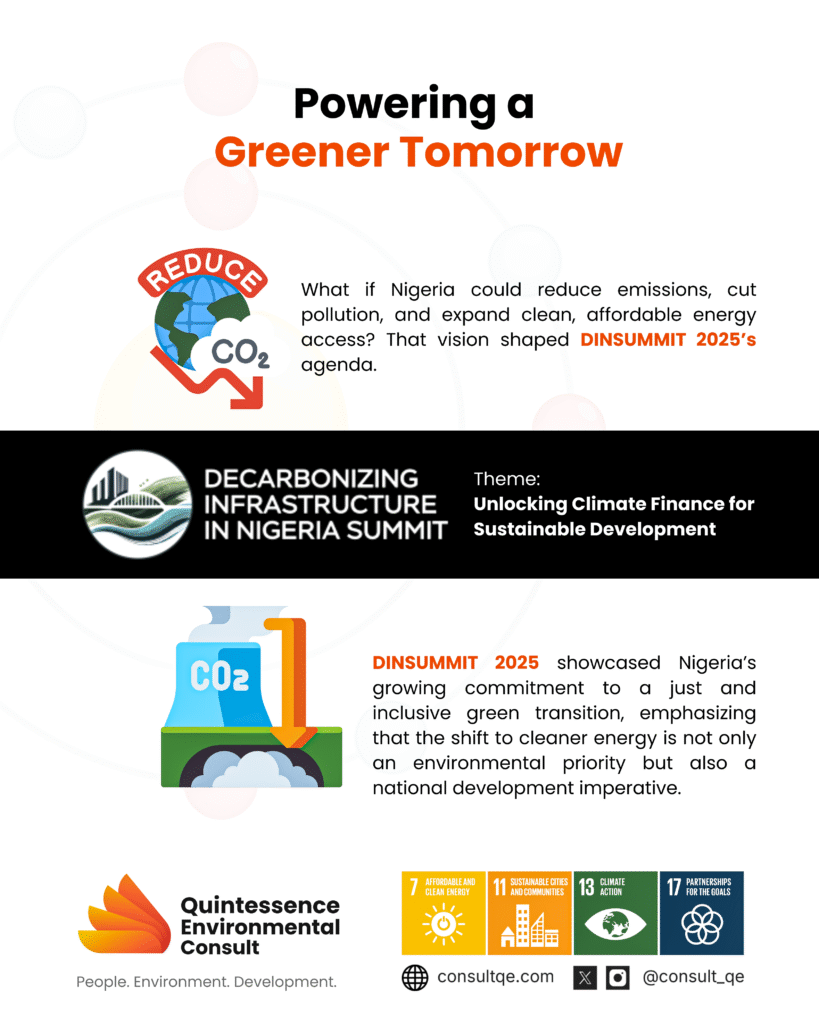
INTRODUCTION
What if Nigeria could cut its carbon emissions, reduce air pollution, and expand clean energy access all at once? That bold vision took center stage at the 2025 Decarbonizing Infrastructure in Nigeria Summit (DINSUMMIT). With the theme “Unlocking Climate Finance for Sustainable Development,” the summit brought together key players from government, industry, and civil society to accelerate Nigeria’s transition away from carbon-intensive energy sources toward a sustainable, low-carbon economy.
For decades, Nigeria’s infrastructure has relied heavily on diesel and other fossil fuels to power construction, operations, and maintenance, especially in critical facilities like hospitals, schools, and government buildings. This dependency has led to high greenhouse gas (GHG) emissions, degraded air quality, and increased public health risks. To address this, the government, through the Office of the Vice President launched DINSUMMIT as a strategic response to the environmental and economic challenges posed by fossil fuel reliance.
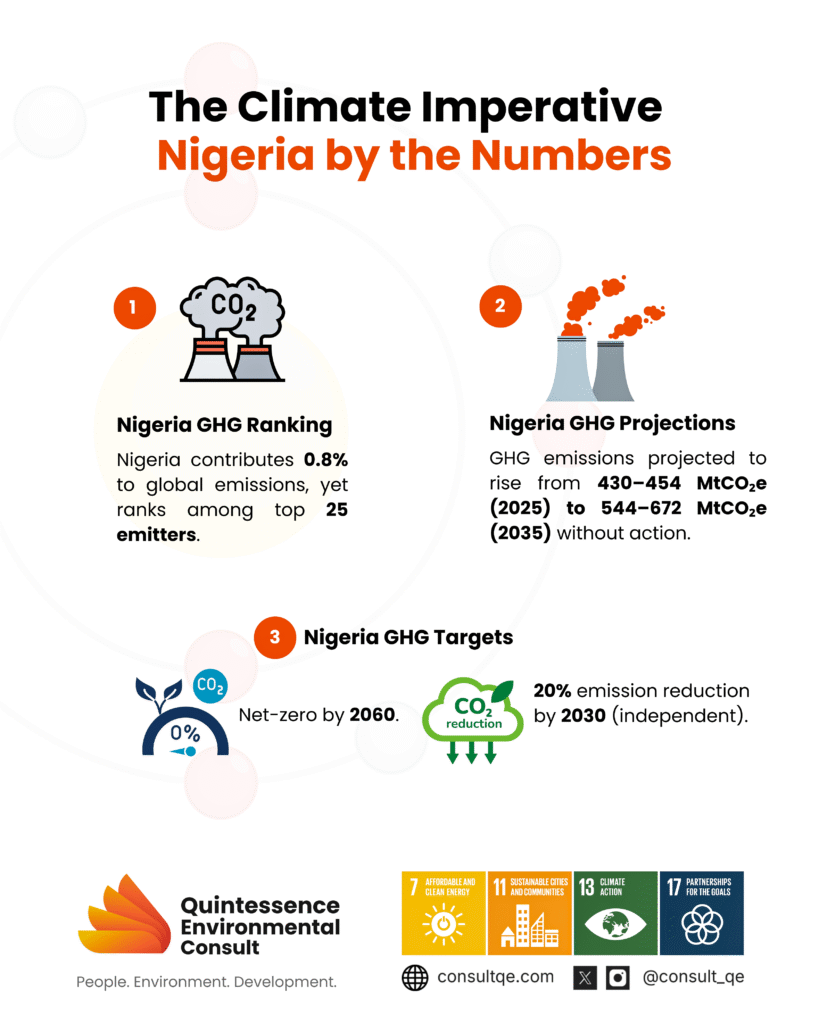
THE CLIMATE IMPERATIVE: NIGERIA BY THE NUMBERS
The urgency of Nigeria’s climate action becomes clear when examining the statistics. Nigeria currently contributes 0.8% of global greenhouse gas emissions, ranking among the top 25 highest emitters worldwide (Jones et al., 2024). The country’s power sector alone generated approximately 21.3 million metric tons of carbon dioxide equivalent in 2023, highlighting the massive scale of the challenge ahead (Olaniwun Ajayi LP, 2025).
Despite representing less than 1% of global emissions, Nigeria faces disproportionate climate risks. The nation has committed to ambitious targets: reducing greenhouse gas emissions by 20% independently by 2030, or by 47% with international support. Most significantly, Nigeria has pledged to achieve net-zero emissions by 2060, demonstrating its commitment to global climate goals.
Current projections show that without intervention, Nigeria’s emissions could rise from 430-454 million tons of CO2 equivalent in 2025 to 544-672 million tons by 2035 (National Council on Climate Change, Nigeria, 2023). This trajectory underscores the critical importance of initiatives like DINSUMMIT in changing course toward a sustainable future.
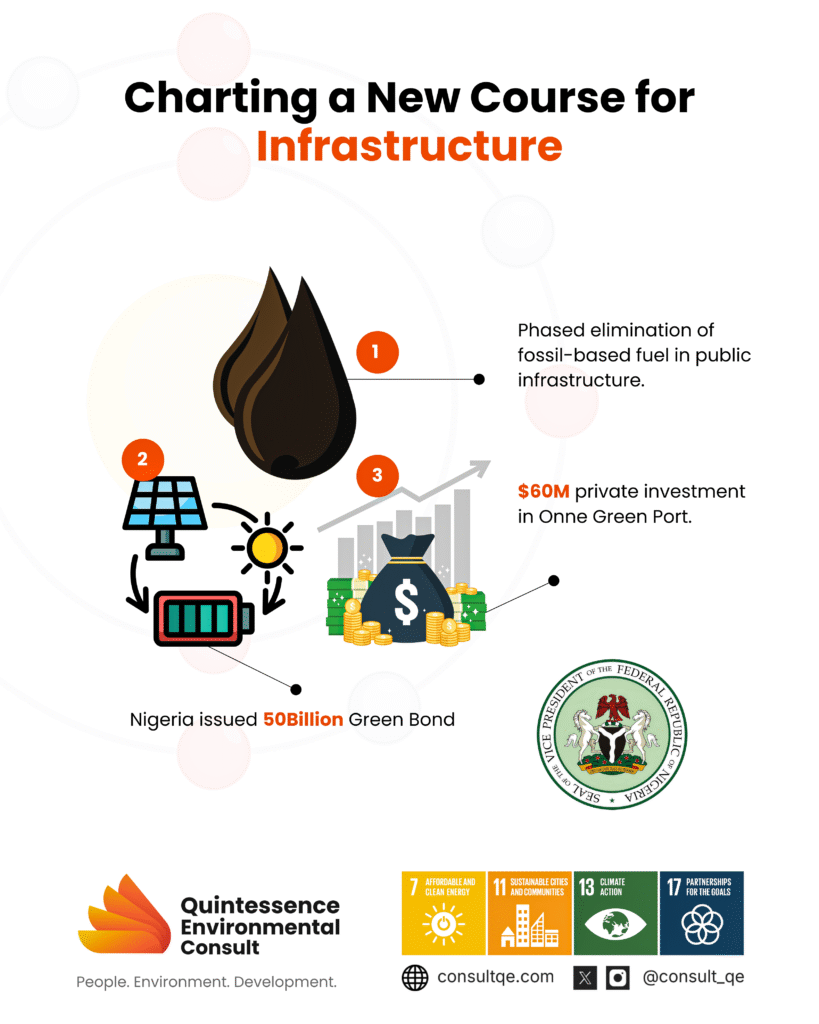
CHARTING A NEW COURSE FOR A SUSTAINABLE NIGERIA
At the summit, His Excellency, the Vice President, Kashim Shettima, announced Nigeria’s phased elimination of diesel use in public infrastructure, aligning with national net-zero targets. He emphasized that climate-smart infrastructure is not just an environmental priority, but a development imperative. A prime example is the ongoing discussions with private investors to commit nearly $60 million on the transformation of Onne Port, situated in Rivers State into a fully green port, an ambitious initiative that reflects Nigeria’s broader push for hybrid energy systems capable of enhancing energy security and lowering emissions.
The summit’s theme underscored the critical role of climate finance in bridging the gap between ambition and execution. Speakers highlighted the importance of accessing international funding sources like the Green Climate Fund (GCF), Global Environment Facility (GEF), and the Adaptation Fund (AF), alongside domestic private sector capital. Sessions explored how project developers can align their projects with Environmental and Social Safeguards (ESS) to meet funders’ eligibility criteria and unlock financing for resilient infrastructure.
Beyond the plenary discussions, the SUMMIT featured live exhibitions of scalable innovations. For example, Quintessence Environmental Consult showcased how their Unmanned Aerial Vehicle (UAV) services support climate action through precision forest monitoring for carbon sequestration projects, wetland health mapping to reduce greenhouse gas emissions, site suitability analysis for solar farms, and flood risk assessments for rapid disaster response. These applications demonstrate that clean technologies are not merely aspirational; they are already operational and scalable across Nigeria. They also demonstrated how project developers can meet climate fund requirements by ensuring compliance with ESS standards.
The summit also emphasized inclusivity. Dr. Nkiruka Maduekwe, Director-General of the National Council on Climate Change (NCCC), emphasized the urgent need for Nigeria to transition to a low-carbon economy, despite its relatively small contribution to global emissions. She stressed Nigeria’s high vulnerability to climate change due to its geographic position and limited adaptive capacity. To build resilience, she called for smart agriculture, renewable energy, and improved land management for carbon sequestration alongside substantial private sector investment in clean energy and transport. Her remarks reinforced a central message: climate action must be inclusive and equitable, ensuring that all Nigerians, from cities to remote communities, benefit from sustainable development.
UNLEASHING NIGERIA’S RENEWABLE ENERGY POTENTIAL
Nigeria’s renewable energy landscape is experiencing unprecedented growth, with capacity expanding at a compound annual growth rate of 9.88% from 2024 to 2034 (Climate Scorecard, 2024).The country’s renewable energy capacity is projected to surge from 3.13 gigawatts in 2024 to 5.01 gigawatts by 2029, representing a transformative shift in the energy sector.
According to Nkalo (2025), key findings for Nigeria’s renewable energy sector show an installed solar capacity of around 112 MW in 2023. marking a significant increase from just a few years earlier. With the country’s abundant sunshine and vast land area, solar energy could play a pivotal role in meeting energy demands while reducing carbon emissions. Current projections suggest that renewable energy sources, including solar, hydropower, and wind, could satisfy nearly 60% of Nigeria’s energy demands by 2050.
The renewable energy transition is not just about environmental benefits—it’s about economic opportunity. According to the International Energy Agency (2023), Nigeria’s National Renewable Energy and Energy Efficiency Policy aims to increase the share of renewable electricity to 23% by 2025, creating thousands of jobs in installation, maintenance, and manufacturing. This growth trajectory positions Nigeria as a potential leader in Africa’s renewable energy revolution.

THE ECONOMIC CASE FOR GREEN INFRASTRUCTURE
The economic implications of Nigeria’s green transition extend far beyond energy savings. The shift to renewable energy and sustainable infrastructure represents a massive economic opportunity, with potential benefits spanning multiple sectors. The renewable energy sector alone is creating employment opportunities across the value chain, from manufacturing and installation to maintenance and technical support.
Moreover, the health economic benefits are substantial. Air pollution from diesel generators and fossil fuel combustion contributes to respiratory diseases, cardiovascular conditions, and other health problems that burden Nigeria’s healthcare system. The transition to clean energy could significantly reduce these health costs while improving the quality of life for millions of Nigerians.
The financial sector Is also recognizing the opportunities. International climate finance mechanisms are increasingly available to support Nigeria’s green transition, with billions of dollars potentially accessible through organizations like the Green Climate Fund, which has committed to supporting developing countries’ climate actions.
DISCUSSION
Decarbonizing infrastructure is not just about transitioning to cleaner energy sources; it delivers broad social and economic benefits. Adopting low-carbon solutions like solar-powered facilities, electric transport, and green buildings can create thousands of jobs in renewable energy installation, maintenance, and manufacturing. These jobs will stimulate local economies and provide meaningful opportunities, especially for Nigeria’s youth.
Health outcomes will also improve as reduced diesel use cuts down on air pollution and respiratory illnesses. Most importantly, a green transition supports climate justice, ensuring that those most affected by climate change such as low-income and rural populations benefit from clean, affordable, and reliable infrastructure.
However, realizing this vision requires deep, sustained collaboration. Although Nigeria has set a clear direction, it must address barriers such as limited concessional finance, regulatory hurdles, and technical capacity gaps. The summit showed that with aligned policy, access to climate finance, and innovation, Nigeria can build infrastructure that is both environmentally sustainable and socially transformative.
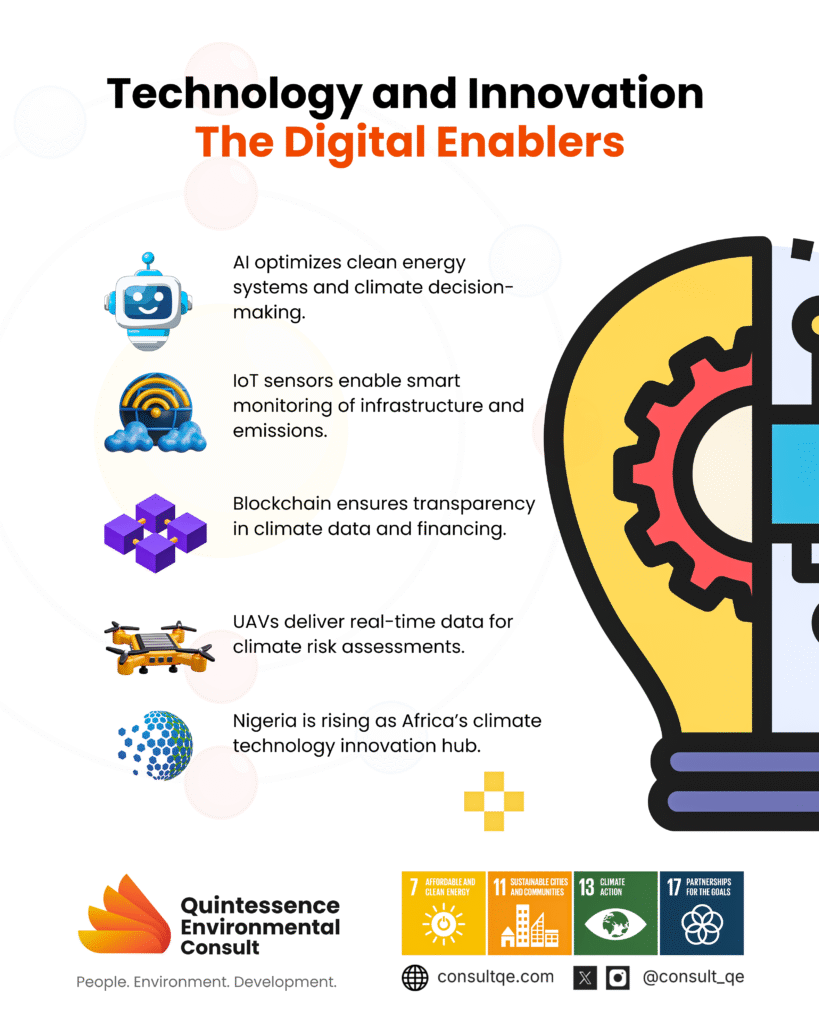
TECHNOLOGY AND INNOVATION: THE DIGITAL ENABLERS
The summit highlighted how cutting-edge technologies are making Nigeria’s green transition both feasible and scalable. Digital solutions, including artificial intelligence, Internet of Things (IoT) sensors, and blockchain technology, are being deployed to optimize renewable energy systems, monitor environmental impacts, and ensure efficient resource utilization.
The demonstration of UAV technology for environmental monitoring exemplifies how innovation is accelerating climate action. These technologies enable precise measurement of carbon sequestration, real-time monitoring of renewable energy installations, and rapid assessment of climate risks. Such innovations are not just supporting Nigeria’s domestic transition but positioning the country as a technology leader in Africa’s climate space.
POLICY FRAMEWORK AND REGULATORY LANDSCAPE
Nigeria’s climate ambitions are supported by a comprehensive policy framework that includes the National Energy Policy, the Renewable Energy Master Plan, and the country’s Nationally Determined Contributions (NDCs) under the Paris Agreement. The government has established the National Council on Climate Change to coordinate climate action across sectors and ensure policy coherence.
The regulatory environment is evolving to support the green transition, with new frameworks for renewable energy development, energy efficiency standards, and environmental safeguards. These policies are designed to attract private investment while ensuring that climate projects meet international standards and deliver measurable benefits.
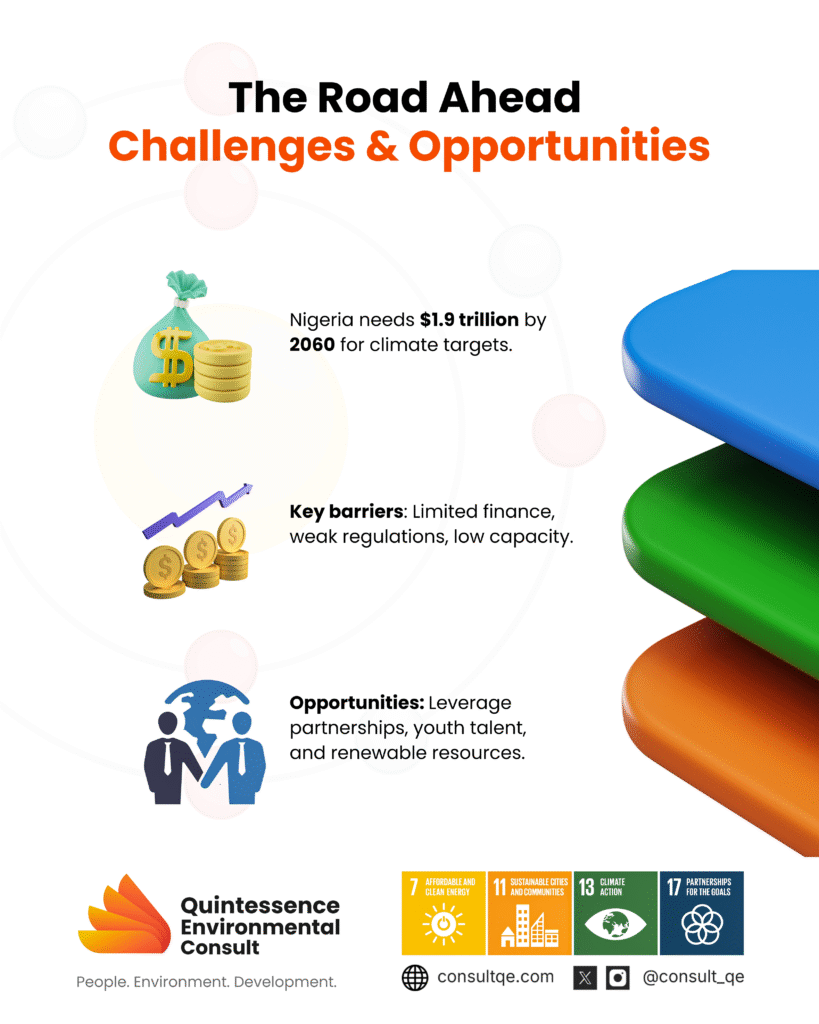
THE ROAD AHEAD: CHALLENGES AND OPPORTUNITIES
While Nigeria’s climate commitments are ambitious, significant challenges remain. Limited access to concessional finance, inadequate grid infrastructure, and capacity constraints in project development and implementation are key barriers that must be addressed. According to the National Council on Climate Change, Nigeria (2023), the financial investment needed to achieve the nation’s 2060 net-zero goal is estimated at $1.9 trillion, highlighting the scale of the financing challenge.
However, these challenges also represent opportunities. The need for massive infrastructure investment opens doors for innovative financing mechanisms, public-private partnerships, and international collaboration. Nigeria’s young, growing population represents a demographic dividend that can drive innovation and economic growth in the green economy.
The country’s abundant natural resources, including solar, wind, and hydropower potential, provide a solid foundation for the renewable energy transition. With proper planning and investment, Nigeria can leapfrog traditional energy infrastructure and build a modern, sustainable energy system.
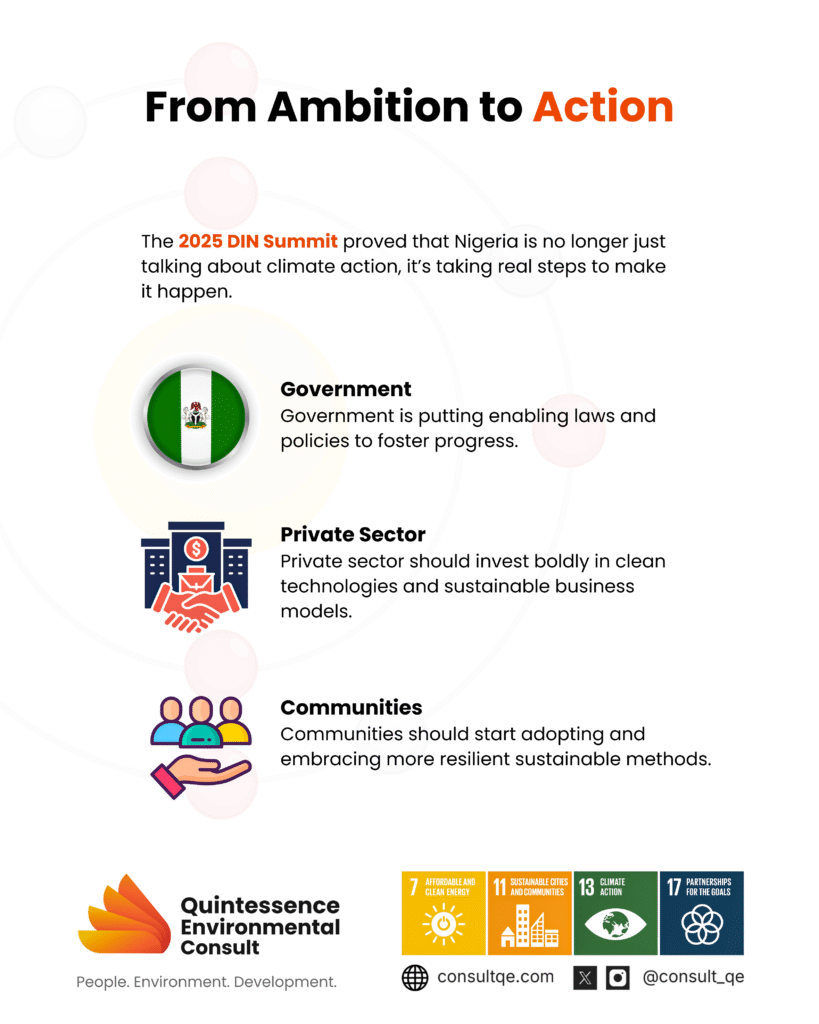
CONCLUSION
The 2025 Decarbonizing Infrastructure in Nigeria Summit demonstrated that Nigeria is not only serious about climate action, but it is also taking bold steps to make it happen. With strong leadership, growing access to finance, and scalable technologies already in play, the country is poised to transition from ambition to impact. The statistics paint a clear picture: Nigeria’s renewable energy capacity is growing at nearly 10% annually, emissions reduction targets are ambitious yet achievable, and the economic benefits of the green transition are substantial.
Yet, building a low-carbon future is a shared responsibility. The government has a crucial role to play in turning climate ambition into action by ensuring that enabling policies are not only in place, but also fully implemented and enforced, the private sector should invest in green solutions, and communities should advocate for inclusive, climate-resilient development.
As we move forward, it is essential that every project, whether a school, road, hospital, or port, is designed with sustainability at its core. Nigeria’s road to net zero does not begin with a single large step, but with thousands of smaller ones. Every solar panel installed, every diesel generator replaced, and every climate-smart policy enacted contributes to progress. The foundation we lay today will determine the strength and sustainability of Nigeria’s future.
Climate Scorecard. (2024, May 22). Nigeria’s renewable energy sector: A beacon of hope for sustainable development. https://www.climatescorecard.org/2024/05/nigerias-renewable-energy-sector-a-beacon-of-hope-for-sustainable-development/
International Energy Agency. (2023). Nigeria – Energy policy review. https://www.iea.org/reports/nigeria-energy-policy-review-2023/executive-summary
Jones, M. W., Peters, G. P., Gasser, T., Andrew, R. M., Schwingshackl, C., Gütschow, J., Houghton, R. A., Friedlingstein, P., & Pongratz, J. (2024, November 13). National contributions to climate change due to historical emissions of carbon dioxide, methane and nitrous oxide. Zenodo. https://doi.org/10.5281/zenodo.14054503
National Council on Climate Change, Nigeria. (2023). Nigeria’s long-term low-emission development strategy – 2060. UNFCCC. https://unfccc.int/documents/634950
Nkalo, U. (2025). Nigeria’s renewable energy sector: Analysis of the present and future prospects. Solar Compass, 14, 100123. https://doi.org/10.1016/j.solcom.2024.100123
Olaniwun Ajayi LP. (2025, May). The energy transition plan: Taking stock of Nigeria’s energy transition progress more than two years on. https://www.olaniwunajayi.net/blog/wp-content/uploads/2025/05/OALP-Energy-Transition-Plan-Power-and-Infrastructure-Article-May-2025.pdf
Presidency of Nigeria. (2025, July 4). Nigeria will end diesel dependency, cut carbon emissions with integrated hybrid energy, says VP Shettima. State House. https://statehouse.gov.ng/news/nigeria-will-end-diesel-dependency-cut-carbon-emissions-with-integrated-hybrid-energy-says-vp-shettima/
The Sun Nigeria. (2025). Nigeria to phase out diesel, slash carbon emissions. The Sun Nigeria. https://thesun.ng/nigeria-to-phase-out-diesel-slash-carbon-emissions-with-hybrid-energy-shettima-announces-at-climate-summit

